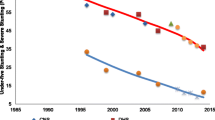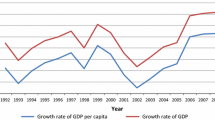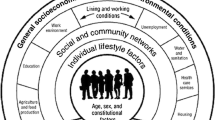Abstract
This paper examines the relationship between measures of income poverty, undernourishment, childhood undernutrition, and child mortality in developing countries. While there is, as expected, a close aggregate correlation between these measures of deprivation, the measures generate some inter-regional paradoxes. Income poverty and child mortality is highest in Sub Saharan Africa, but childhood undernutrition is by far the highest in South Asia, while the share of people with insufficient calories (undernourishment) is highest in the Caribbean. The paper finds that standard explanations cannot account for these inter-regional paradoxes, particularly the ones related to undernourishment and childhood undernutrition. The paper suggests that measurement issues related to the way undernourishment and childhood undernutrition are measured might play a significant role in affecting these inter-regional puzzles, and points to implications for research and policy.
Similar content being viewed by others
References
Adams, R.: Economic growth, inequality and poverty: estimating the growth elasticity of poverty. World Dev 32(12), 1989–2014 (2004)
Anand, S., Ravallion, M.: Human development in poor countries: on the role of private incomes and public services. J. Econ. Perspect. 7, 133–150 (1993)
Anand, S., Bärninghausen, T: Human resource and health outcomes: cross-country econometric study. Lancet 364, 1603–1609 (2004)
Bhandari, N., Bahl, R., Taneja, S., de Onis, M, Bhan, M.: Growth performance of affluent Indian children is similar to that in developed countries. Bull. W.H.O. 80(3), 189–195 (2002)
Bogin, B.: Patterns of Human Growth. Cambridge University Press, Cambridge (1988)
Bourguignon, F.: The growth elasticity of poverty reduction: explaining heterogeneity across countries and time periods. In: Eichler, T., Turnovsky, S. (eds) Growth and Inequality. MIT, Cambridge (2003)
Brinkman, H., Drukker, J., Slot, B.: GDP per capita and the biological standard of living in contemporary developing countries. In: Baten, J., Komlos, J. (eds) The Biological Standard of Living. Springer, Berlin Heidelberg New York (1997)
Datt, G., Ravallion, M.: Growth and redistribution components of changes in poverty measures: a decomposition with application to Brazil and India in the 1980s. J. Dev. Econ. 38(2), 275–295 (1992)
Davies, D.P.: The importance of genetic influences on growth in early childhood with particular reference to children of asiatic origin. In: Waterlow, J. (ed) Linear Growth Retardation in Developing Countries. Raven, New York (1988)
Deaton, A.: The Analysis of Household Surveys. Johns Hopkins University Press, Baltimore (1997)
Devarajan, S., Miller, M., Swanson, E.: Goals for Development. (Policy Research Working Paper No. 2819). The World Bank, Washington DC (2002)
Drèze, J., Sen, A.: Hunger and Public Action. Oxford University Press, New York (1989)
Eveleth, P., Tanner, J.: Worldwide Variation in Human Growth. Cambridge University Press, Cambridge (1990)
FAO (ed.) Measurement and Assessment of Food Deprivation and Undernutrition. FAO, Rome (2003)
Gallup, J., Sachs, J.: The economic burden of malaria. Am. J. Trop. Med. Hyg. 64(1,2), S: 85–96 (2001)
Graitcer, P., Gentry, E.: Measuring children: one reference for all. Lancet 2(8241), 297–299 (1981)
Gorstein, J. et al.: Issues in the assessment of nutritional status using anthropometry. Bull. W.H.O. 72, 273–283 (1994)
Guilkey, D., Riphahn, R.: The determinants of child mortality in the Philippines: estimation of a structural model. J. Dev. Econ. 56, 281–305 (1998)
Habicht, J.P. et al.: Height and weight in pre-school children: how relevant are ethnic differences in growth potential? Lancet 1, 611–614 (1974)
Harttgen, K., Misselhorn, M.: A multilevel approach to explain child mortality and undernutrition in South Asia and sub-Saharan Africa. Mimeographed, University of Göttingen (2006)
Kidd, K.K. et al.: Minisatellite diversity supports a recent African origin for modern humans. Nat. Genet. 13, 154–160 (1996).
Klasen, S., Misselhorn, M.: Determinants of the growth semielasticity of poverty reduction. Mimeographed, University of Göttingen (2006)
Klasen, S.: Measuring poverty and deprivation in South Africa. Rev. Income Wealth 46, 33–58 (2000a)
Klasen, S.: Malnourished and Surviving in South Asia, Better Nourished and Dying Young in Africa: What Can Explain this Puzzle? SFB Working Paper No. 214. Department of Statistics, Munich (2000b)
Klasen, S. Malnourished and surviving in South Asia, better nourished and dying young in Africa: what can explain this puzzle? In: FAO (ed) Measurement and Assessment of Food Deprivation and Undernutrition. FAO, Rome, pp. 283–287 (2003)
Klasen, S., Moradi, A.: The Nutritional Status of Elites in India, Kenya, and Zambia: an Appropriate Guide for Developing Reference Standards for Undernutrition? SFB Discussion Paper No. 217. Department of Statistics, Munich (2000)
Lancet: A measure of agreement on growth standards. Lancet 1(8369), 142–143 (1984, Editorial)
Lence, S.: Household expenditure survey methods. In: FAO (ed) Measurement and Assessment of Food Deprivation and Undernutrition. FAO, Rome, pp. 91–96 (2003)
Lipton, M., Ravallion, M.: Poverty and policy. In: Behrman, J., Srinivasan, T.N. (eds) Handbook of Development Economics, Vol 3b. North Holland, Amsterdam (1995)
Martorell, R., Mendoza, F., Castillo, R.: Poverty and stature in children. Waterlow, J (ed) Linear Growth Retardation in Developing Countries. Raven, New York (1988)
McGillivray, M.: Measuring non-economic well-being achievement. Rev. Income Wealth 51(2), 337–365 (2005)
MacFarlane, S.B.: A universal growth reference of fool’s gold? Eur. J. Clin. Nutr. 49, 745–753 (1995)
Mohamed, A.J., Onyango, A.W., de Onis, M., Prakash, N., Mabry, R.M., Alasfoor, D.H.: Socioeconomic predictors of unconstrained child growth in Muscat, Oman. East. Mediterr. Health J. 10, 295–302 (2004)
Mosk, C.: Making Health Work: Human Growth in Modern Japan. University of California Press, Berkeley, CA (1996)
Mosley, W., Chen, L.: An analytical framework for the study of child survival in developing countries. In: Mosley, W. (ed) Child Survival: Strategies for Research. Population Council, New York (1984)
Naiken, L.: FAO methodology for estimating the prevalence of food deprivation and undernutrition. In: FAO (ed) Measurement and Assessment of Food Deprivation and Undernutrition. FAO, Rome, pp. 7–42 (2003)
Nussbaum, M., Sen, A.: The Quality of Life. Oxford University Press, New York (1993)
de Onis, M., Habicht, J.P.: Anthropometric reference data for international use: recommendations from a World Health Organization Expert Committee. Am. J. Clin. Nutr. 64, 650–658 (1996)
de Onis, M., Garza, S.: Foreword. Acta Pediatr. (Supplement) 450, 5–6 (2006)
Osmani, S.R.: Poverty and nutrition in South Asia. In: UN Sub-Committee on Nutrition (eds) Nutrition and Poverty. WHO, Geneva (1997)
Osmani, S.R.: Nutrition and the economics of food: implications of some recent controversies. In: Dreze, J., Sen, A. (eds) The Political Economy of Hunger, Vol. 1. Oxford University Press, New York (1990)
Osmani, S., Sen, A.: The hidden penalties of gender inequality: fetal origins of ill-health. Economics and Human Biology 1(1), 105–121 (2003)
Pelletier, D.: Malnutrition, morbidity, and child mortality in developing countries. In: United Nations (eds.) Too Young to Die: Genes or Gender? United Nations, New York (1998)
Pelletier, D.: The relationship between child anthropometry and mortality in developing countries. J. Nutr. (Supplement) 124, 2047S–2081S (1994)
Pelletier, D., Frongillo, E., Habicht, J.-P.: Epidemiological Evidence for a potentiaing effect of malnutrition on child mortality. Am. J. Public Health 83, 1130–1133 (1993)
Pritchett, L., Summers, L.: Wealthier is healthier. J. Hum. Resour. 31, 841–868 (1996)
Ravallion, M.: Poverty Comparisons. Harwood, Chur (1994)
Ramalingaswami, V., Jonsson, U., Rohde, J.: The South Asian enigma. In: UNICEF (ed) The Progress of Nations. UNICEF, New York (1996)
Seckler, D.: Small but healthy: a basic hypothesis in the theory, measurement and policy of malnutrition. In: Sukhatme, D. (ed) Newer Concepts in Nutrition and their Implication for Policy. Maharashtra Association for the Cultivation of Science, Pune (1982)
Sen, A.: Development as Freedom. Knopf, New York (1998)
Sen, A.: The concept of development. In: Chenery, H., Srinivasan, T.N. (eds) Handbook of Development Economics. North-Holland, Amsterdam (1988)
Sen, A.: Poverty and Famines. Oxford University Press, Oxford (1984)
Smith, L., Haddad, L.: Explaining child malnutrition in developing countries: a cross-country analysis. IFPRI discussion paper no. 60. IFPRI, Washington DC (1999)
Smith, L., Haddad, L.: How potent is economic growth in reducing undernutrition? What are the pathways of impact? New cross-country evidence. Econ. Dev. Cult. Change 51, 55–76 (2002)
Smith, L., Ramakrishnan, U., Haddad, L., Martorell, R., Ndyae, A.: The importance of women’s status for child nutrition in developing countries. IFPRI research report no. 131. IFPRI, Washington DC (2003)
Smith, L.: The use of household expenditure surveys for the assessment of food insecurity. In FAO (ed) Measurement and Assessment of Food Deprivation and Undernutrition. FAO, Rome, pp. 57–88 (2003)
Sukhatme, D.: Measurement of undernutrition. Econ. Polit. Wkly. 17 (1982)
Svedberg, P.: 841 million undernourished? World Dev. 28 (1999)
Svedberg, P.: Undernutrition overestimated. Econ. Dev. Cult. Change 51(1), 5–36 (2002)
UNDP: Human Development Report. Oxford University Press, New York (1990, 2000)
UNICEF: The State of World’s Children: Focus on Nutrition. UNICEF, New York (1998)
WHO: Measuring Change in Nutritional Status. WHO, Geneva (1983)
WHO: Physical Status: the use and Interpretation of Anthropometry. WHO technical report series no. 854. WHO, Geneva (1995)
WHO: Infant and Young Child Nutrition: the WHO Multicentre Growth Reference Study. WHO implementations and resolutions EB105/inf.doc./I. WHO, Geneva (1999)
WHO Multicentre Growth Reference Study Group: WHO child growth standards based on length/height, weight, and age. Acta Paediatr. (Suppl.) 450, 76–85 (2006a)
WHO Multicentre Growth Reference Study Group: Enrolment and baseline characteristics in the WHO multicentre growth reference study. Acta Paediatr. (Suppl.) 450, 5–15 (2006b)
WHO Multicentre Growth Reference Study Group: Assessment of differences in linear growth among populations in the WHO Multicentre Growth Reference Study. Acta Paediatr. (Suppl.) 450, 56–65 (2006c)
World Bank: World Development Indicators. The World Bank, Washington DC (2005)
World Bank: World Development Report 2000/01: Attacking Poverty. Oxford University Press, New York (2000)
World Bank: Confronting AIDS. The World Bank, Washington DC (1997)
World Bank: World Development Report 1993: Investing in Health. Oxford University Press, New York (1993)
Author information
Authors and Affiliations
Corresponding author
Additional information
An erratum to this article can be found at http://dx.doi.org/10.1007/s10888-008-9079-y
Rights and permissions
About this article
Cite this article
Klasen, S. Poverty, undernutrition, and child mortality: Some inter-regional puzzles and their implicationsfor research and policy. J Econ Inequal 6, 89–115 (2008). https://doi.org/10.1007/s10888-007-9056-x
Received:
Accepted:
Published:
Issue Date:
DOI: https://doi.org/10.1007/s10888-007-9056-x




